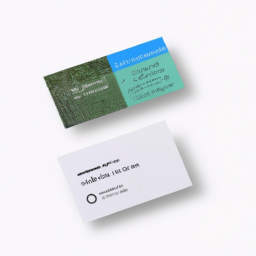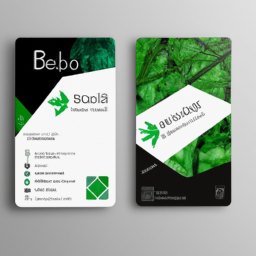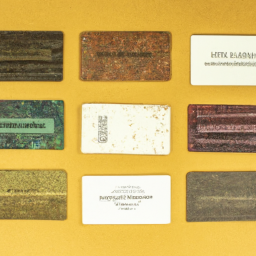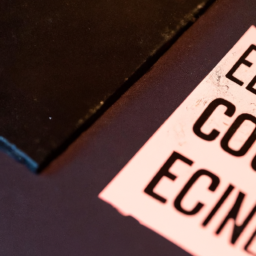Eco-friendly business cards offer a range of benefits for companies seeking to minimize their environmental impact and appeal to environmentally conscious customers. By utilizing sustainable materials and printing techniques, businesses can reduce their carbon footprint while enhancing their brand reputation. These eco-friendly cards not only attract environmentally conscious customers but also provide a competitive advantage in today’s market.
Materials such as recycled paper, bamboo, and cork, paired with printing techniques like soy-based inks and waterless printing, make for a greener and more sustainable option. These materials and techniques not only reduce the use of harmful chemicals and resources but also contribute to the preservation of forests and wildlife habitats.
In addition to their environmental benefits, eco-friendly business cards also offer long-term cost-effectiveness. While they may have a slightly higher upfront cost compared to traditional cards, the use of sustainable materials and printing techniques can result in significant savings over time. For example, using recycled paper reduces the need for virgin materials, which can be more expensive to produce.
Moreover, eco-friendly business cards align with corporate social responsibility and support a circular economy. Companies that prioritize sustainability and take steps to reduce their environmental impact are seen as responsible and forward-thinking. By using eco-friendly business cards, businesses demonstrate their commitment to sustainability and contribute to the development of a more sustainable economy.
In conclusion, eco-friendly business cards provide numerous advantages for companies. They not only help reduce the environmental impact but also attract environmentally conscious customers and provide a competitive edge in the market. Additionally, these cards offer long-term cost-effectiveness and align with corporate social responsibility. By choosing eco-friendly business cards, companies can make a positive impact on the environment while enhancing their brand reputation.
Key Takeaways
- Sustainable materials for business cards, such as recycled paper and FSC-certified paper, reduce deforestation and support the circular economy.
- Eco-friendly printing techniques, like soy-based inks and waterless printing, minimize the release of harmful chemicals and conserve water resources.
- Adopting eco-friendly practices enhances brand reputation and showcases a commitment to reducing environmental impact.
- Businesses that prioritize sustainability with eco-friendly business cards and printing techniques attract environmentally conscious customers, gaining a competitive advantage and contributing to a positive social impact.
Reduced Environmental Impact

Using sustainable materials and printing techniques for business cards can significantly reduce their environmental impact. By opting for cost-effective alternatives such as recycled paper, FSC-certified paper, plantable paper, bamboo, or cork, businesses can minimize their carbon footprint and contribute to eco-friendly business practices.
These materials are sourced responsibly, minimizing deforestation and promoting a sustainable future. Additionally, eco-friendly printing techniques like soy-based inks, waterless printing, digital printing, letterpress printing, and UV coating alternatives further reduce the environmental impact of business cards. These techniques minimize the use of harmful chemicals and conserve water resources.
Enhanced Brand Reputation

By adopting eco-friendly practices, businesses can enhance their brand reputation and appeal to environmentally conscious customers. Building customer trust and creating a positive brand association are crucial for long-term success.
Eco-friendly business cards play a significant role in achieving these goals. Using sustainable materials like recycled paper, FSC-certified paper, plantable paper, bamboo, or cork showcases a commitment to reducing environmental impact. Employing eco-friendly printing techniques such as soy-based inks, waterless printing, and digital printing further reinforces the brand’s dedication to sustainability.
Design options like minimalistic designs, embossed or debossed elements, die-cut shapes, and foil stamping with eco-friendly materials can create a unique and visually appealing card.
Attraction of Environmentally Conscious Customers

Environmentally conscious customers are drawn to businesses that prioritize sustainability and demonstrate a commitment to reducing their environmental impact. By using eco-friendly business cards made from sustainable materials and employing environmentally friendly printing techniques, businesses can attract these green consumers and gain marketing advantages.
Sustainable materials such as recycled paper, FSC-certified paper, plantable paper, bamboo, and cork can significantly reduce the environmental impact of business cards. Additionally, using eco-friendly printing techniques like soy-based inks, waterless printing, digital printing, letterpress printing, and opting for UV coating alternatives further reinforces a business’s commitment to sustainability.
Competitive Advantage

Businesses that prioritize eco-friendly practices and invest in sustainable alternatives for their business cards gain a competitive advantage in the market. By adopting eco-friendly materials and printing techniques, they not only reduce their environmental impact but also attract environmentally conscious customers.
The benefits of using eco-friendly business cards extend beyond just sustainability. These businesses experience cost savings in the long run due to the use of sustainable materials and printing techniques. Additionally, by showcasing their commitment to the environment, they build a positive brand image and enhance customer loyalty.
Customers are more likely to support businesses that align with their values and show corporate social responsibility. By investing in eco-friendly business cards, companies not only contribute to a sustainable future but also position themselves ahead of their competitors.
Sustainable Material Options

Using recycled paper, FSC-certified paper, plantable paper, bamboo, or cork are all sustainable options for business cards.
Recycled paper alternatives are an excellent choice for eco-friendly business cards as they help reduce deforestation and waste. By using recycled paper, businesses can contribute to a circular economy and minimize their environmental impact.
Additionally, bamboo is gaining popularity as a sustainable material for business cards due to its rapid growth and regenerative properties. Bamboo can be harvested in just a few years, making it a highly renewable resource. Furthermore, bamboo has natural antimicrobial properties, making it a hygienic choice for business cards.
Using bamboo not only showcases a commitment to sustainability but also adds a unique and stylish touch to business cards.
Eco-friendly Printing Techniques

Digital printing is a cost-effective and efficient technique for producing eco-friendly business cards. Compared to traditional printing techniques, digital printing offers several advantages, especially when it comes to sustainability.
One key advantage is the use of soy-based inks, which are derived from renewable resources and have lower volatile organic compound (VOC) emissions. These inks not only reduce environmental impact but also offer vibrant colors and sharp detail.
Additionally, digital printing eliminates the need for plates, reducing waste and energy consumption. With its precise and high-quality output, digital printing ensures minimal material and ink wastage.
Frequently Asked Questions
Are There Any Other Sustainable Material Options for Business Cards Besides Recycled Paper and Fsc-Certified Paper?
There are indeed other sustainable material options available for business cards besides recycled paper and FSC-certified paper. Some innovative alternatives include plantable paper, which contains seeds that can be planted after use, and materials like bamboo and cork, which are renewable and environmentally friendly.
In terms of printing techniques, there are options such as soy-based inks, waterless printing, and UV coating alternatives that can further enhance the eco-friendliness of business cards.
These alternatives offer businesses a wider range of choices to create sustainable and impactful business cards.
How Do Eco-Friendly Printing Techniques Such as Soy-Based Inks and Waterless Printing Contribute to Reducing Environmental Impact?
Soy-based inks and waterless printing, known as green printing techniques, contribute to reducing environmental impact.
Soy-based inks are made from renewable resources and have lower volatile organic compound (VOC) emissions compared to traditional petroleum-based inks.
Waterless printing eliminates the need for water, reducing water consumption and pollution.
Both techniques help minimize the carbon footprint of printing and promote sustainability.
Can Using Eco-Friendly Business Cards Really Enhance a Brand’s Reputation and Customer Loyalty?
Using eco-friendly business cards can indeed enhance a brand’s reputation and customer loyalty. By demonstrating a commitment to sustainability and environmental responsibility, businesses can attract and retain customers who prioritize these values.
Eco-friendly business cards showcase a company’s dedication to making a positive impact on the environment, which can build trust and loyalty among environmentally conscious consumers.
Additionally, by aligning with corporate social responsibility, businesses can differentiate themselves from competitors and create a positive brand image.
Besides Attracting Environmentally Conscious Customers, What Other Advantages Can Eco-Friendly Business Cards Provide in Terms of Competitive Advantage?
Eco-friendly business cards serve as a marketing tool that goes beyond attracting environmentally conscious customers. They provide a competitive advantage by enhancing a brand’s reputation and customer loyalty.
Moreover, they contribute to cost effectiveness in the long run, align with corporate social responsibility, and support a circular economy. By opting for sustainable materials and printing techniques, businesses can build a positive brand image and demonstrate their commitment to sustainability, which can give them an edge over their competitors.
How Do Eco-Friendly Business Cards Support a Circular Economy and Contribute to a Sustainable Future?
Eco-friendly business cards support a circular economy by using sustainable materials and printing techniques. This reduces waste and promotes resource efficiency. By utilizing recycled or FSC-certified paper, as well as eco-friendly printing methods like soy-based inks and waterless printing, these cards minimize their environmental impact.
This commitment to sustainability not only contributes to a sustainable future but also enhances brand reputation and attracts environmentally conscious customers. Overall, eco-friendly business cards offer numerous circular economy benefits and help build a more sustainable world.
Conclusion
In conclusion, eco-friendly business cards offer a range of benefits for businesses seeking to reduce their environmental impact and appeal to environmentally conscious customers.
By using sustainable materials such as recycled paper, FSC-certified paper, and plantable paper, businesses can contribute to a sustainable future and minimize their carbon footprint.
Additionally, employing eco-friendly printing techniques like soy-based inks and waterless printing further reduces environmental harm.
Not only do these choices enhance brand reputation and attract environmentally conscious customers, but they also provide a competitive advantage in today’s market.
Ultimately, opting for eco-friendly business cards aligns with corporate social responsibility and supports the creation of a circular economy.